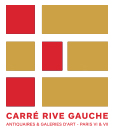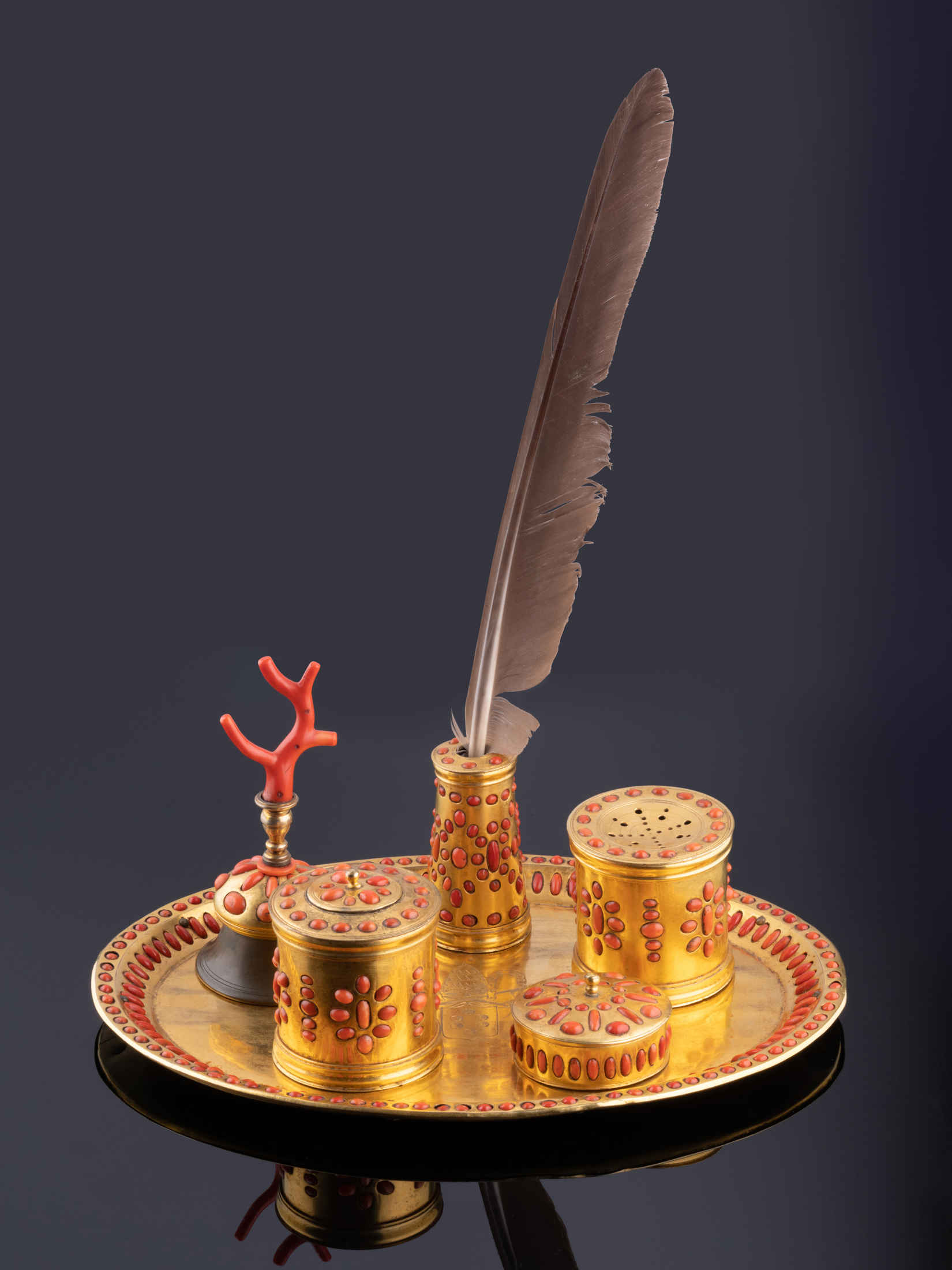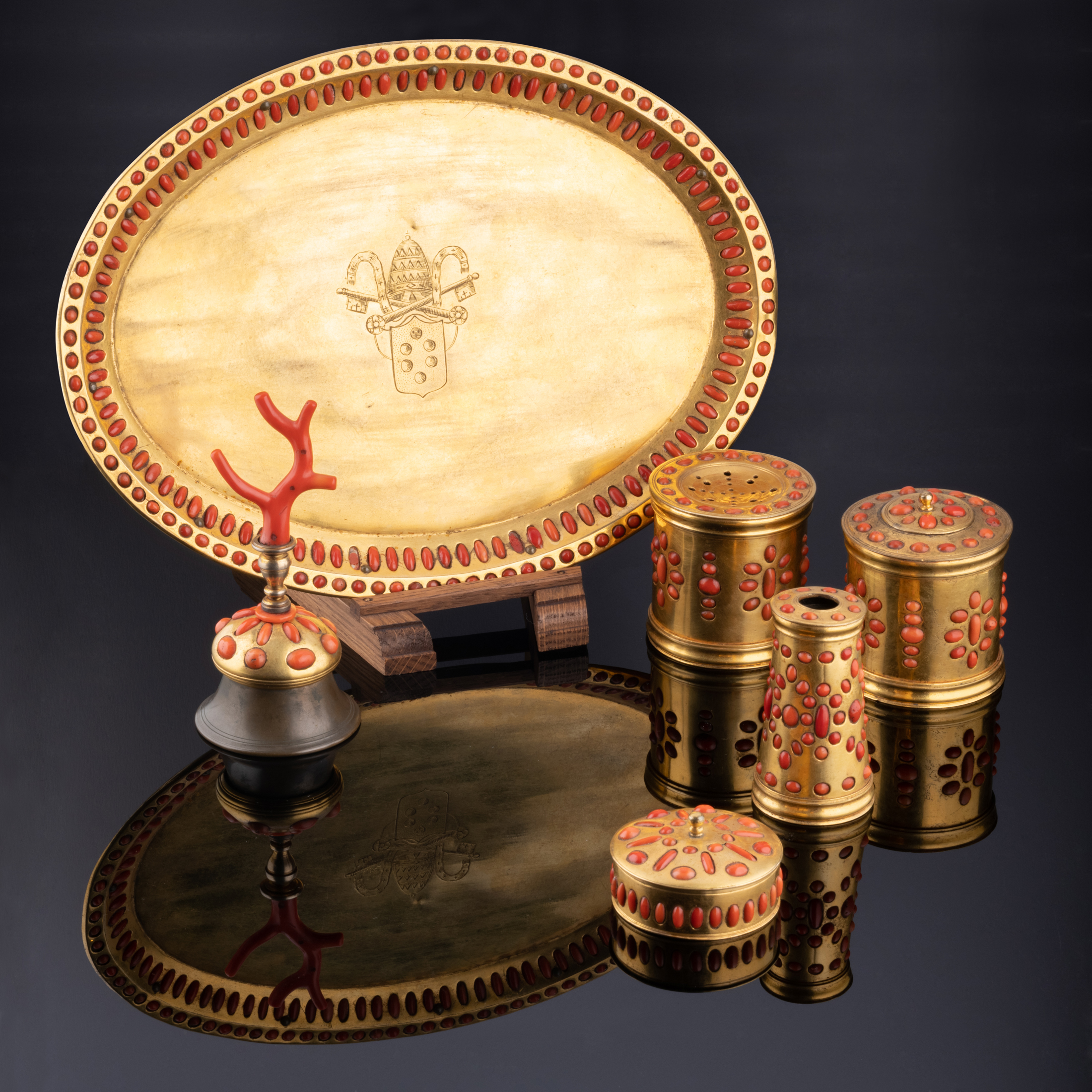Description
Cet ensemble d’exception est un encrier en cuivre doré et corail dit de Trapani. Dès la fin du Moyen-Âge, la ville de Trapani en Sicile devient un important foyer artistique du fait de ses récifs coralliens. Cette cité portuaire accueillait une grande population israélite, mais également des chrétiens et des musulmans, qui prêtaient au corail un pouvoir divin. Au XVIe siècle, cette matière était considérée comme rare et précieuse car elle était très difficile d’extraction. La popularité du corail vient aussi du goût de l’époque pour les sciences naturelles et les cabinets de curiosité.
Jusqu’au XVIIIe siècle, la ville de Trapani possédait des ateliers spécialisés dans les oeuvres en cuivre doré orné de corail et cette production était exclusive à la région. D’un côté, de nombreux objets religieux se sont développés notamment car, chez les chrétiens, le corail symbolise le sang du Christ et on lui attribuait des vertus magiques.
De l’autre, ces objets pouvaient être profanes et étaient destinés à des galeries ou des pièces d’apparat de familles aristocrates.
En général, les plus belles pièces servaient de cadeaux diplomatiques et étaient destinées aux cours européennes. Notre ensemble en fait partie car il porte le blason de la famille Médicis. La période à laquelle on attribue cet objet nous permet de penser qu’il était destiné au Pape Léon XI, de son vrai nom Alexandre Ottaviano de Médicis.
Une étiquette au dos du plateau indique que l’ensemble appartenait à la collection d’Antonio Virga (1923-2001). Ce collectionneur de Palerme avait un goût particulier pour les arts décoratifs siciliens, plus précisément ceux des XVe et XVIe siècles. Antonio Virga se distinguait par sa volonté d’acquérir d’acquérir des objets issus de domaines artistiques longtemps considérés comme mineurs et qui pourtant suscitaient depuis longtemps l’intérêt, ainsi que de très belles pièces dignes d’être exposées dans les grands musées.
Cet encrier représente donc un très beau témoignage de la production d’oeuvres en corail de Trapani. Il permet d’appréhender l’importance de ce foyer artistique au XVIe siècle mais également celle de sa diffusion grâce aux cadeaux diplomatiques.
__________________________________________
This exceptional set is a gilded copper and coral inkwell known as Trapani. From the end of the Middle Ages, the town of Trapani in Sicily became an important artistic centre because of its coral reefs. This port city was home to a large Israelite population, but also to Christians and Muslims, who believed that the coral had divine power. In the 16th century, this material was considered rare and valuable because it was very difficult to extract. The popularity of coral also stems from the taste of the time for natural sciences and curiosity cabinets.
Until the 18th century, the city of Trapani had workshops specialising in works in gilded copper decorated with coral and this production was exclusive to the region. On the one hand, many religious objects were developed, particularly because, among Christians, coral symbolises the blood of Christ and was attributed magical virtues.
On the other hand, these objects could be secular and were intended for galleries or the ceremonial rooms of aristocratic families.
In general, the most beautiful pieces were used as diplomatic gifts and were destined for European courts. Our ensemble is one of them because it bears the coat of arms of the Medici family. The period to which this object is attributed leads us to believe that it was intended for Pope Leo XI, whose real name was Alexander Ottaviano de Medici.
A label on the back of the tray indicates that the set belonged to the collection of Antonio Virga (1923-2001). This collector from Palermo had a particular taste for Sicilian decorative arts, more specifically those of the 15th and 16th centuries. Antonio Virga was distinguished by his willingness to acquire objects from fields of art that were long considered minor, but which have long attracted interest, as well as some very fine pieces worthy of being exhibited in major museums.
This inkwell therefore represents a beautiful testimony to the production of coral works in Trapani. It provides an insight into the importance of this artistic centre in the 16th century, but also into its spread through diplomatic gifts.



